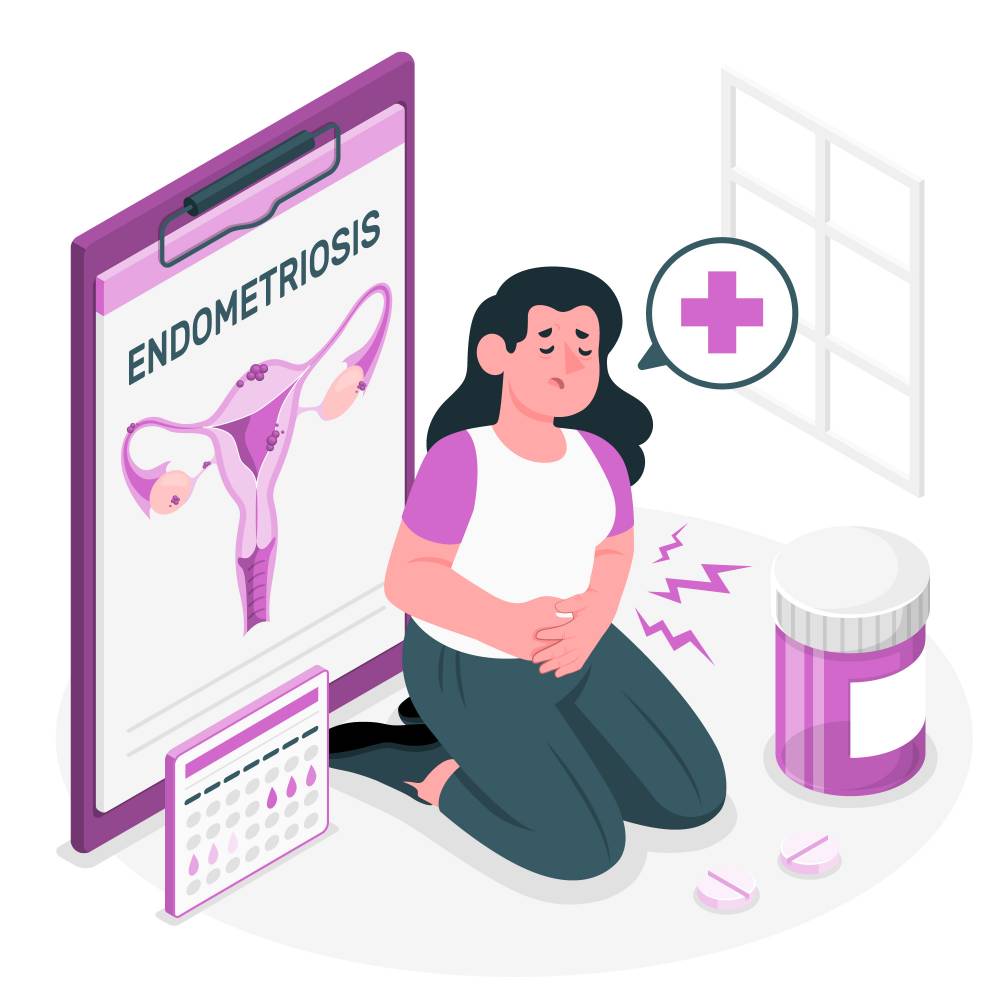What is Endometriosis?
Endometriosis is a chronic condition where endometrium-like tissue, normally found lining the uterus, grows in abnormal locations outside the uterus. With each menstrual cycle, this misplaced tissue thickens, breaks down, and bleeds, but because it has no way to leave the body, it becomes trapped.1 This leads to chronic inflammation, scarring, adhesions, and in severe cases, organ dysfunction.
Globally, endometriosis affects approximately 190 million women, making it one of the most prevalent gynecological disorders.2 The condition severely impacts quality of life, often leading to painful periods, bowel and bladder dysfunction, fatigue, and infertility. The socioeconomic burden is substantial, as many women experience disruptions in education, work, and daily life. The primary goals of treatment focus on pain reduction, fertility preservation, and prevention of complications such as fibrosis, adhesions, and, in rare cases, malignant transformation.1

More Than a Reproductive Disease: The Systemic Effects of Endometriosis
Traditionally classified as a gynecological disorder, endometriosis extends far beyond the reproductive system. Emerging research highlights its impact on the brain, immune system, and metabolism, positioning it as a multi-system inflammatory disease rather than just a hormonal disorder.3
A study in mice induced with endometriosis demonstrated significant neurological and behavioral changes, including increased anxiety, depression, and heightened pain sensitivity. Further analysis revealed alterations in brain gene expression and electrophysiology, suggesting that endometriosis may contribute to chronic pain sensitization and mood disorders observed in women with the condition. These findings indicate that the brain’s response to chronic pelvic inflammation could be a key driver of neurological symptoms in endometriosis patients. 4
Additionally, chronic inflammation in endometriosis has been linked to immune dysfunction, with studies reporting an imbalance in immune cell activity. This dysregulation can impair natural immune surveillance, potentially increasing susceptibility to other inflammatory and autoimmune diseases.
The Crisis of Underdiagnosis and Underfunding
Despite its high prevalence, endometriosis remains severely underdiagnosed, with an average diagnostic delay of 7–9 years. 5 This pattern has remained unchanged for decades, resulting in prolonged patient suffering and suboptimal treatment outcomes.
In Denmark, only 2% of reproductive-age women receive a formal diagnosis, even though estimates suggest 10% of women are affected. Research shows that women with endometriosis use healthcare services 19% more frequently than those without the condition, particularly in the ten years before diagnosis. These findings suggest that many women struggle with symptoms for years before receiving appropriate care.6,7
A lack of research funding compounds the issue. A recent analysis of European Union framework programs found that only 27 out of 145,983 funded projects (0.02%) were related to endometriosis. In the United States, endometriosis research funding in 2022 totaled just $16 million, translating to $2 per patient per year. By comparison, Crohn’s disease, which affects around 690,000 people, received $90 million in funding, equating to $130 per patient—over 65 times more than endometriosis research.8,9
Despite its disease burden, endometriosis receives disproportionately less funding than other chronic conditions such as diabetes and inflammatory bowel disease, limiting advancements in diagnostic tools, treatment options, and patient care.
Why Is Endometriosis So Underdiagnosed?
A major factor contributing to delayed diagnosis is the normalization of menstrual pain. Society has long dismissed pelvic pain as a normal part of menstruation, leading women to underreport symptoms or delay seeking medical help. Healthcare providers may also underestimate the severity of symptoms, assuming they are part of the normal menstrual cycle rather than a sign of a chronic disease.10,11
The lack of specific diagnostic tools further complicates detection. Endometriosis symptoms mimic other conditions like irritable bowel syndrome (IBS) and pelvic inflammatory disease (PID), leading to frequent misdiagnoses. Currently, the gold standard for diagnosis remains laparoscopic surgery, an invasive procedure that many doctors hesitate to recommend without severe symptoms. The absence of non-invasive, reliable diagnostic tests means that many cases go undetected for years.12
Medical bias exacerbates the problem. Women of color and those from lower-income backgrounds face greater barriers to diagnosis, including healthcare inaccessibility and symptom dismissal. Many endure years of pain and misdiagnosis, leading to unnecessary suffering, infertility risks, and mental health struggles.13
References:
Wang, P. H., Yang, S. T., Chang, W. H., Liu, C. H., Lee, F. K., & Lee, W. L. (2022). Endometriosis: Part I. Basic concept. Taiwanese journal of obstetrics & gynecology, 61(6), 927–934. https://doi.org/10.1016/j.tjog.2022.08.002
World Health Organization (WHO). Endometriosis. Fact sheets. https://www.who.int/news-room/fact-sheets/detail/endometriosis (2023).
Chen LH, Lo WC, Huang HY, Wu HM. A Lifelong Impact on Endometriosis: Pathophysiology and Pharmacological Treatment. Int J Mol Sci. 2023 Apr 19;24(8):7503. doi: 10.3390/ijms24087503. PMID: 37108664; PMCID: PMC10139092.
Li T, Mamillapalli R, Ding S, Chang H, Liu ZW, Gao XB, Taylor HS. Endometriosis alters brain electrophysiology, gene expression and increases pain sensitization, anxiety, and depression in female mice. Biol Reprod. 2018 Aug 1;99(2):349-359. doi: 10.1093/biolre/ioy035. PMID: 29425272; PMCID: PMC6692844.
Saunders, P. T. K. & Horne, A. W. Endometriosis: Etiology, pathobiology, and therapeutic prospects. Cell 184, 2807–2824 (2021).
Illum, L. R. H. et al. Temporal and regional differences in the incidence of hospital-diagnosed endometriosis: a Danish population-based study. Acta Obstet. Gynecol. Scand. 101, 737–746(2022).
Melgaard, A. et al. Utilization of healthcare prior to endometriosis diagnosis: a Danish case-control study. Hum. Reprod. 38, 1910–1917 (2023).
Viganò, P., Casalechi, M. & Dolmans, M. M. European Union underinvestment in endometriosis research. J. Endometr. Uterine Disord. 5, 100058 (2024).
Kirk, U.B., Bank-Mikkelsen, A.S., Rytter, D. et al. Understanding endometriosis underfunding and its detrimental impact on awareness and research. npj Womens Health2, 45 (2024). https://doi.org/10.1038/s44294-024-00048-6
Wiggleton-Little J. "Just" a painful period: A philosophical perspective review of the dismissal of menstrual pain. Womens Health (Lond). 2024 Jan-Dec;20:17455057241255646. doi: 10.1177/17455057241255646. PMID: 38773901; PMCID: PMC11113068.
Harzif AK, Nurbaeti P, Sayogo Putri A, Silvana V, Andyra AF, Wiweko B. Factors associated with delayed diagnosis of endometriosis: A systematic review. Journal of Endometriosis and Pelvic Pain Disorders. 2024;0(0). doi:10.1177/22840265241291120
Dantkale KS, Agrawal M. A Comprehensive Review of the Diagnostic Landscape of Endometriosis: Assessing Tools, Uncovering Strengths, and Acknowledging Limitations. Cureus. 2024 Mar 26;16(3):e56978. doi: 10.7759/cureus.56978. PMID: 38665720; PMCID: PMC11045176.
Center for Community Health Partnership & Research. (2022). Health inequities in endometriosis care






Post comments